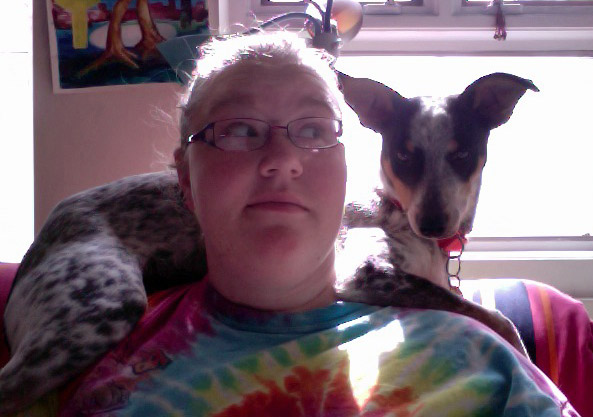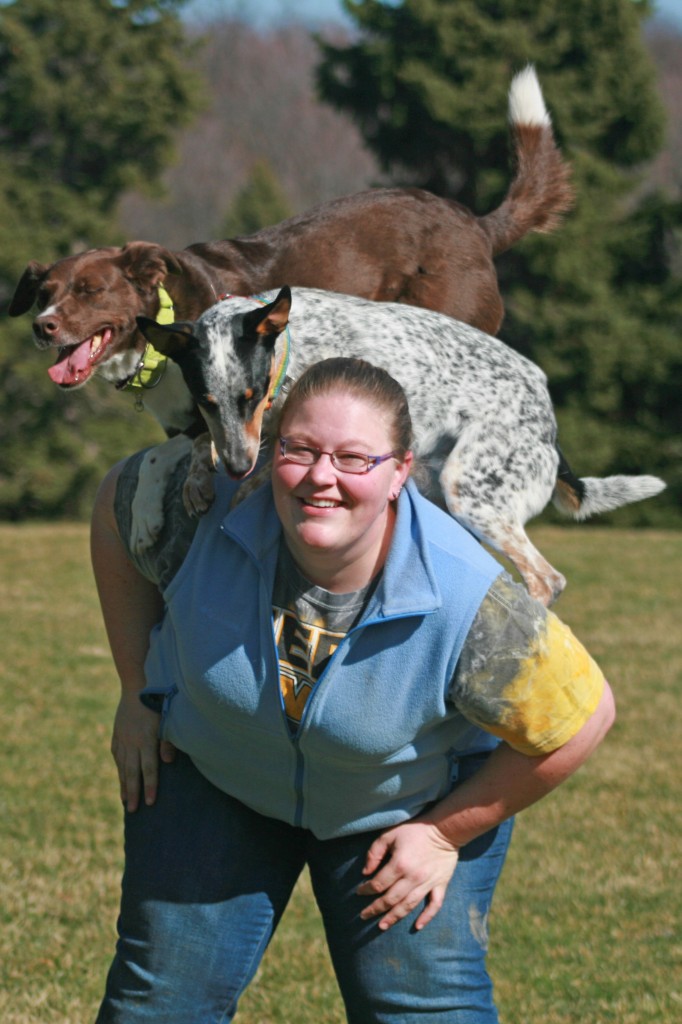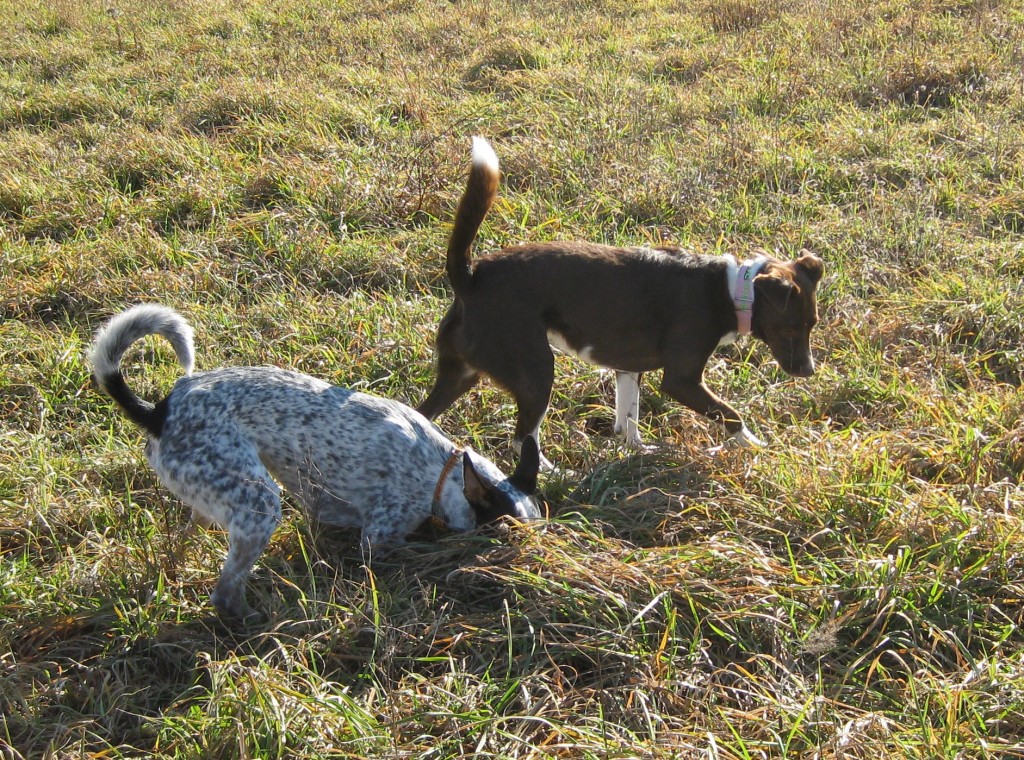Hey! That’s Not Dominance!
I regularly get asked questions from dog guardians that are worried about their dog being dominant (this happens more often than I would like to mention). They are often genuinely concerned because they’ve either heard a T.V. personality or a friend say that if their dog does some behavior that the dog is being dominant and trying to take over the role as “alpha”. Some of these may sound ridiculous, but these are actual concerns that have been brought to my attention.
Help! My dog is being dominant by leaning into me and claiming my space! How can I correct that?!
If your dog is leaning into you, take it as a compliment. He’s seeking out affection and seeking out attention. He is not trying to dominate you–though he is being a little forward in how he is seeking your attention. It’s also probably a matter of a behavior that has been rewardedhistorically–he’s learned the leaning into you will get ear scratches, butt scratches, and general snuggles. If you have a huge dog and a small body and you don’t like the lean, just don’t reward it and cue him to do something else (like a sit) so you can lavish him with cuddles for something other than leaning.
*When leaning, or variations of leaning, could become problematic is if the dog is pushing you away from things more than just leaning in. If you notice that every time you try to sit on the couch your dog blocks your way and pushes you out of the way, it may be more along the lines of resource guarding and not an attention seeking behavior.

Puppy Rio loved to sit on the couch behind my shoulders to look out the window (he still does actually).
My dog likes to sit on the back of the couch, is he trying to dominate me?
Probably not. The back of the couch is a hot commodity in my house (and a place the Rio has always liked to sit–weird dog). Often, dogs like to sit on the back of the couch to look out of windows, to be able to avoid other animals playing on the ground or a way to get close to their human if another animal is occupying the cushion next to the person. They aren’t trying to be dominant, they are more likely trying to get a view out of a window or be close to their person.
*This behavior could be problematic if the dog is resource guarding the person they are sitting behind or the couch itself.
My dog likes to sit on my feet or put his head or paws n my lap if I’m sitting down or nudge my hands to get pet. I can’t have him trying to be the alpha, what can I do?
All of these behaviors are attention seeking behaviors. Your dog likes you and wants to try and be in the same space as you (which can be annoying at times). They are seeking out your affection and physically touching you–they aren’t trying to dominate you. If you like a little bit of space and would prefer your dog not intentionally sitting on your feet or putting their feet in your lap, teach them a “move over” cue or heavily reinforce them for laying down close to you but not on you.
*This behavior could be concerning if it was paired with resource guarding you from other animals or people or if it is a manifestation of separation anxiety.
Someone told me that when my puppy jumps up that he’s trying to be dominant, he jumps on everyone, is he really trying to be dominant?
Dogs, jump up for a bunch of reasons. Often, they want to get close to our faces to say hello (what wild canids do when parents return to the area with food, they jump up an lick faces) and the only way to do that is to jump up, they are excited to see us and want to get close to us (again common behavior among young wild canids), and probably most commonly, jumping up is simply a behavior that has been reinforced over time and is a way the dog knows to get attention. While the jumping can be annoying and painful at times, it’s not about dominance.
*Jumping up may be a serious problem if your dog is doing what’s called a “muzzle punch.” A muzzle punch is when a dog forcefully bops into a person with a closed mouth–this typically, though not exclusively, happens when jumping up. A muzzle punch is a distance increasing behavior–“get away from me!” and a potential precursor to a bite, so it is a concerning behavior (still not dominance)
My brother told me that I had to make my dog walk behind me at all times and go out of all the doors first or else my dog would become dominant and aggressive, is that true?
No.
Dogs pull on leash for a few reasons but the most common is because humans are naturally slow movers. Our normal gait is a walk, theirs is a more efficient trot, this is their cruising speed. Have you ever had to hold the hand of a toddler and walk with them? It’s painfully slow. That’s what your dog feels like as we go out for ‘walks’ and they would like to go out for a trot. So they are pulling because they are naturally faster than us and they are excited to get out of the house they’ve been stuck in all day. The same concept goes for walking through doors first–they have been stuck in the house all day and are excited to get their 30-60 minute constitutional (so to speak). They aren’t being dominant, they are excited. Both of these non-dominance issues are simply training issues.
*This may be concerning behavior if… well, neither of these have any big concerning things from the dog’s perspective (in terms of a bigger behavior concern). It can be concerning if the safety of the human is being put at risk of being pulled or knocked over or if the safety of the dog is at risk in that the handler can’t hold onto the leash or the dog bolts out doors.
My dog’s tail is always really high and over his back. Someone at the dog park got really upset and told me that it means he’s dominant and shouldn’t be at the park!?
Many dogs have naturally high tail sets and their tails being raised is nothing alarming at all. Breeds like huskys, malamutes, shih tzus, shar peis, and shiba inus all have tails that are tall and curled over their backs naturally and breeds like beagles, fox hounds, many pointers, and terriers like the airedale can all have tails that are often quite vertical. Rio has a very low natural tail set but his tail is often high and curled over his back when he is excited, really happy, hanging with doggie friends at the farm, and hunting. A tall tail alone is not alarming and certainly isn’t automatically a sign of dominance.
*A high tail can be problematic when there are other concerning body language features as well. Very high tail, stiff body, and a staccato (fast/flagging) tail wag can be problematic, but it’s not instantly a sign of dominance. Shayne used to be nervous and insecure around other dogs and one of her body language pieces is a tall, stiff, and flagging tail. It’s not a good sign, but it’s not dominance either.
So there you have it! The most frequent dominance questions I get asked. Don’t get hung up on some label that doesn’t even really apply to the species in the way that people are trying to use it. Describe the behavior, learn to interpret the behavior, and then figure out the function of that behavior (what is the dog getting out of it)–from that point you can figure out what your dog means by it.



ha! I was often told Daisy is dominant. No, she can be rude and pushy but she responded brilliantly to training and still loves to do training or play games. In the cold we’ve been playing hide and seek. Great recall practice! Sunshine loves this game because it involves FOOD!